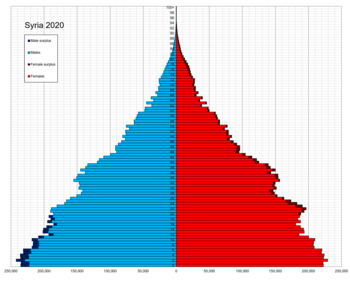Our website is made possible by displaying online advertisements to our visitors.
Please consider supporting us by disabling your ad blocker.
Demographics of Syria
| Demographics of Syria | |
|---|---|
 Population pyramid of Syria in 2020 | |
| Population | 23,865,423 (2024 est.)[1] |
| Density | 140/km2 (360/sq mi) (2024 est.) |
| Growth rate | 4.57% (2024 est.) |
| Birth rate | 21.7 births/1,000 population (2024 est.) |
| Death rate | 4 deaths/1,000 population (2024 est.) |
| Life expectancy | 74.8 years (2024 est.) |
| • male | 73.4 years |
| • female | 76.4 years |
| Fertility rate | 2.69 children born/woman (2024 est.) |
| Infant mortality rate | 15.1 deaths/1,000 live births (2024 est.) |
| Net migration rate | -1.1 migrant(s)/1,000 population (2024 est.) |
| Age structure | |
| 0–14 years | 33% (male 4,037,493/female 3,828,777) |
| 15–64 years | 62.8% (male 7,475,355/female 7,522,797) |
| 65 and over | 4.2% (2024 est.) (male 468,730/female 532,271) |
| Sex ratio | |
| Total | 1.01 male(s)/female (2024 est.) |
| At birth | 1.06 male(s)/female |
| Under 15 | 1.05 male(s)/female |
| 15–64 years | 0.99 male(s)/female |
| 65 and over | 0.88 male(s)/female |
| Nationality | |
| Nationality | noun: Syrian(s) adjective: Syrian |
| Major ethnic |
|
| Minor ethnic |
|
| Language | |
| Official | Arabic |
| Spoken | Kurdish, Turkish, Neo-Aramaic (Turoyo, Western Neo-Aramaic, Suret (Assyrian and Chaldean) |
Syria's estimated pre–Syrian Civil War 2011 population was 22 ±.5[2] million permanent inhabitants, which included 21,124,000 Syrians,[3] as well as 1.3 million Iraqi refugees[4] and over 500,000 Palestinian refugees.[4] The war makes an accurate count of the Syrian population difficult, as the numbers of Syrian refugees,[5] internally displaced Syrians and casualty numbers are in flux. The CIA World Factbook showed an estimated 20.4m people as of July 2021.[6] Of the pre-war population, six million are refugees outside the country, seven million are internally displaced, three million live in rebel-held territory, and two million live in the Kurdish-ruled Autonomous Administration of North and East Syria.
Most modern-day Syrians are commonly described as Arabs by virtue of their modern-day language and bonds to Arab culture and history. But they are, in fact, genetically a blend of the various Semitic-speaking groups indigenous to the region.[7][8][9][10] With around 10% of the population, Kurds are the second biggest ethnic group in Syria, followed by Turkmen.
- ^ "Syria", The World Factbook, Central Intelligence Agency, 2024-09-17, retrieved 2024-09-24
- ^ "Syria's drained population". The Economist. 30 September 2015. Archived from the original on 15 August 2017. Retrieved 12 August 2017.
- ^ "Population Existed in Syria According To Censuses (1960, 1970, 1981, 1994, 2004) And Estimates of Their Number in Mid Years 2005–2011(000)". Central Bureau of Statistics. Archived from the original on 23 October 2015. Retrieved 18 October 2015.
- ^ a b "World Refugee Survey 2008". U.S. Committee for Refugees and Immigrants. 19 June 2008. Archived from the original on 28 December 2012.
- ^ "Syria Regional Refugee Response". UNHCR Syria Regional Refugee Response. 4 July 2019. Archived from the original on 19 July 2019. Retrieved 18 July 2019.
- ^ "The World Factbook: Syria". CIA Library. Retrieved 22 December 2018.
- ^ Michael Haag (2009). The Templars: The History and the Myth - From Solomon's Temple to the Freemasons. Profile Books Limited. p. 65. ISBN 9781846681530. Archived from the original on 2017-10-19. Retrieved 2015-11-14.
- ^ Badro, Danielle A.; Douaihy, Bouchra; Haber, Marc; Youhanna, Sonia C.; Salloum, Angélique; Ghassibe-Sabbagh, Michella; Johnsrud, Brian; Khazen, Georges; Matisoo-Smith, Elizabeth; Soria-Hernanz, David F.; Wells, R. Spencer; Tyler-Smith, Chris; Platt, Daniel E.; Zalloua, Pierre A. (30 January 2013). "Y-Chromosome and mtDNA Genetics Reveal Significant Contrasts in Affinities of Modern Middle Eastern Populations with European and African Populations". PLOS ONE. 8 (1): e54616. Bibcode:2013PLoSO...854616B. doi:10.1371/journal.pone.0054616. PMC 3559847. PMID 23382925.
- ^ El-Sibai, Mirvat; Platt, Daniel E.; Haber, Marc; Xue, Yali; Youhanna, Sonia C.; Wells, R. Spencer; zaabel, Hassan; Sanyoura, May F.; Harmanani, Haidar; Bonab, Maziar Ashrafian; Behbehani, Jaafar; Hashwa, Fuad; Tyler-Smith, Chris; Zalloua, Pierre A. (16 August 2009). "Geographical Structure of the Y-chromosomal Genetic Landscape of the Levant: A coastal-inland contrast". Annals of Human Genetics. 73 (6): 568–581. doi:10.1111/j.1469-1809.2009.00538.x. PMC 3312577. PMID 19686289.
- ^ John Joseph (2000). The Modern Assyrians of the Middle East. BRILL. p. 30. ISBN 978-9004116412. Archived from the original on 2017-10-19. Retrieved 2015-11-14.
Previous Page Next Page


